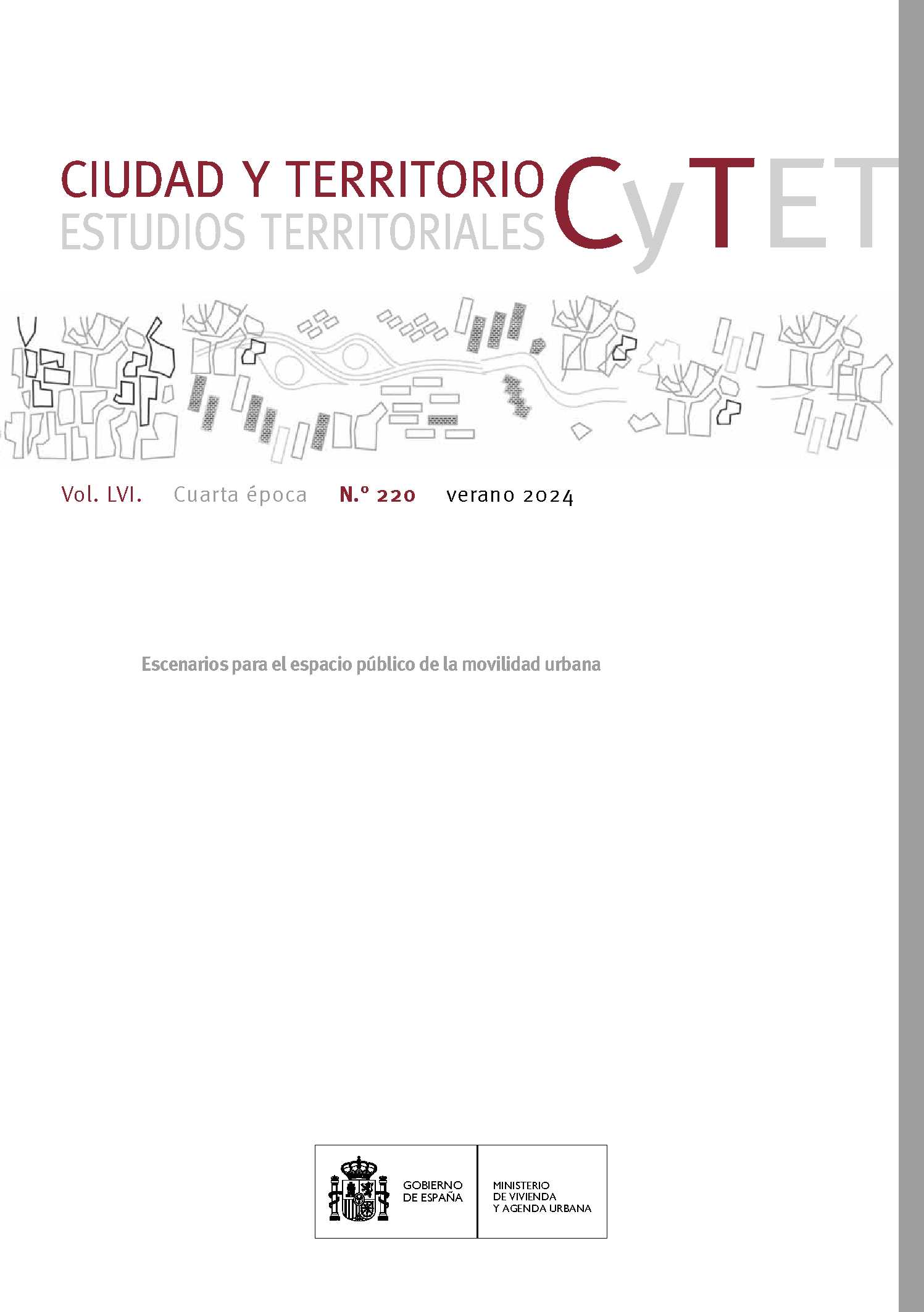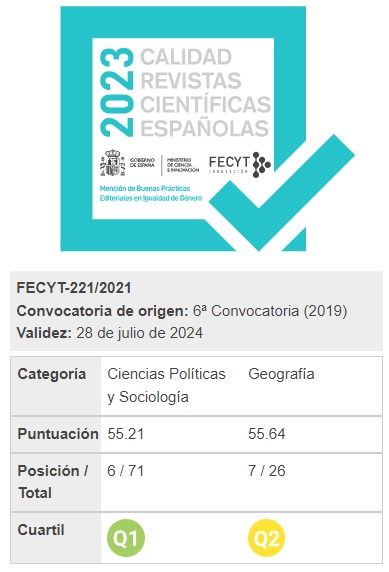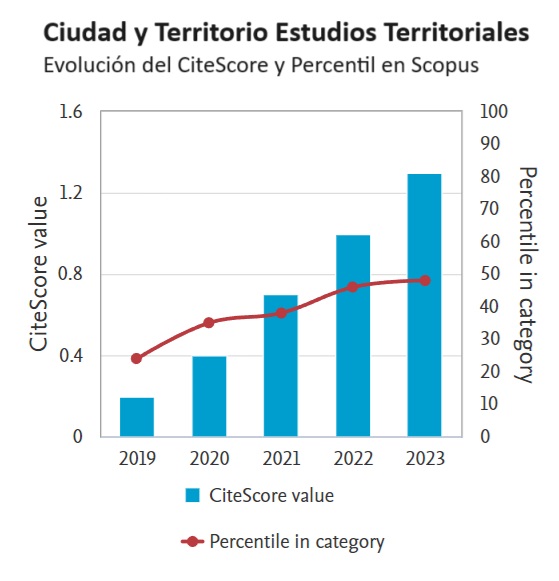Places of care in mobility environments: a method for diagnosis through geolocated social networks
DOI:
https://doi.org/10.37230/CyTET.2024.220.12Keywords:
Mobility of care, Places of care, Activities of care, Urban Spaces, Accessibility, GenderAbstract
This research addresses the existing gap between urban mobility theory and the dimensions of care, as well as their practical application of these theories in cities. Following a comprehensive review of previous studies, a taxonomic classification of places of care is developed, and a method is proposed to diagnose their availability and diversity in pedestrian-accessible urban environments within 200m, 400m, and 800m from light rail stations. This method was applied on Line 2 of the TRAM in Alicante, Spain, using the social network Google Places as the main source of information. The results emphasize the importance of addressing the 3-minute scale (200m) in urban environments surrounding light rail stations and the limited representation of places of care in these areas. In addition, there is a significant imbalance compared to the overall offer of economic and urban activity, particularly pronounced in the most vulnerable neighborhoods.
Downloads
References
ALAMRI, S. & ADHINUGRAHA, K. & ALLHEEIB, N. & TANIAR, D. (2023): GIS Analysis of Adequate Accessibility to Public Transportation in Metropolitan Areas. ISPRS International Journal of Geo-Information, 12(5), 180. https://doi.org/10.3390/IJGI12050180
ARAYA PÉREZ, M. I. (2011): El cuidado familiar de adultos mayores y discapacitados en Chile. El trabajo del cuidado En América Latina y España, 153–160.
BERNABEU-BAUTISTA, Á. & SERRANO-ESTRADA, L. & MARTÍ, P. (2022): Social Media Data Collection and Quality for Urban Studies. Smart Innovation, Systems and Technologies, 246, 229–248. https://doi.org/10.1007/978-981-16-3398-0_11
BERNABEU-BAUTISTA, Á. & SERRANO-ESTRADA, L. & PEREZ-SANCHEZ, V. R. & MARTI, P. (2021): The Geography of Social Media Data in Urban Areas: Representativeness and Complementarity. ISPRS International Journal of Geo-Information 2021, Vol. 10, Page 747, 10(11), 747. https://doi.org/10.3390/IJGI10110747
BIRCH, C. P. D. & OOM, S. P. & BEECHAM, J. A. (2007): Rectangular and hexagonal grids used for observation, experiment and simulation in ecology. Ecological Modelling, 206(3–4), 347–359. https://doi.org/10.1016/j.ecolmodel.2007.03.041
BORZACCHIELLO, M. T. & NIJKAMP, P. & KOOMEN, E. (2010): Accessibility and Urban Development: A Grid-Based Comparative Statistical Analysis of Dutch Cities. Environment and Planning B: Urban Analytics and City Science, 37(1), 148–169. https://doi.org/10.1068/B34126
CARR, D. B. & OLSEN, A. R. & WHITE, D. (1992): Hexagon Mosaic Maps for Display of Univariate and Bivariate Geographical Data. Cartography and Geographic Information Systems, 19(4), 228–236. https://doi.org/10.1559/152304092783721231
CARPIO-PINEDO, J. & DE GREGORIO HURTADO, S. & SÁNCHEZ DE MADARIAGA, I. (2019): Gender Mainstreaming in Urban Planning: The Potential of Geographic Information Systems and Open Data Sources. Planning Theory and Practice, 20(2), 221–240. https://doi.org/10.1080/14649357.2019.1598567
CHAKOUR, V. & ELURU, N. (2016): Examining the influence of stop level infrastructure and built environment on bus ridership in Montreal. Journal of Transport Geography, 51, 205–217. https://doi.org/10.1016/j.jtrangeo.2016.01.007
CHAVA, J. & NEWMAN, P. & TIWARI, R. (2018): Gentrification of station areas and its impact on transit ridership. Case Studies on Transport Policy, 6(1), 1–10. https://doi.org/10.1016/j.cstp.2018.01.007
CHINCHILLA, I. (2020): La ciudad de los cuidados (I. Chinchilla (ed.)). Los libros de la Catarata.
CIOCOLETTO, A. (2014): Espacios para la vida cotidiana. Auditoría de Calidad Urbana con perspectiva de Género. Editorial Comanegra, 2(18), 73.
COL·LECTIU PUNT 6. (2019): Urbanismo feminista por una transformación radical de los espacios de vida. Barcelona, Virus Editorial.
DÍAZ-FERNÁNDEZ, M. & LLORENTE-MARRÓN, M. D. & DEMA-MORENO, S. (2017): Tratamiento económico y modelización del cuidado. Convergencia-Revista De Ciencias Sociales, 25, 37–56.
DOMÍNGUEZ GUEDEA, M. T. & GARCÍA, A. O.& RIVERA SANDER, M. A. (2013): Bienestar, Apoyo Social y Contexto Familiar de Cuidadores de Adultos Mayores. Acta de Investigación Psicológica, 3(1), 1018–1030. https://doi.org/10.1016/S2007-4719(13)70949-9
DURÁN, M. Á. (2011): El trabajo del cuidado en el marco macroeconómico. El trabajo del cuidado en América Latina y España, 11–32.
ECHAVARRI ALFARO, C. E. & DOMÍNGUEZ GUEDEA, M. T. (2015): Relación entre la distribución familiar de las tareas de cuidado y el bienestar percibido por cuidadores familiares de adultos mayores.
ESPINOZA HERRERA, R. (2016): Una mirada al involucramiento paterno: participación de los hombres jefes de hogar de la Gran Área Metropolitana de Costa Rica en actividades de cuidado directo. Estudios Demográficos y Urbanos, 31(2), 301–329.
ESQUIVEL, V. & FAUR, E. & JELIN, E. (2012): Las lógicas del cuidado infantil. Entre las familias, el Estado y el mercado. Buenos Aires. IDES.
EUROFOUND. (2016): European Quality of Life Survey 2016 | Eurofound. https://www.eurofound.europa.eu/es/surveys/european-quality-of-life-surveys/european-quality-of-life-survey-2016
FOROUHAR, A. & VAN LIEROP, D. (2021): If you build it, they will change: Evaluating the impact of commuter rail stations on real estate values and neighborhood composition in the Rotterdam–the Hague metropolitan area, the Netherlands. Journal of Transport and Land Use, 14(1), 949–973. https://doi.org/10.5198/JTLU.2021.1795
GALINDO MENESES, E. A. (2017): Economía del cuidado: una expresión sustantiva de la economía. Scripta Ethnologica, XXXIX (Desarrollo Regional de El Colegio de Tlaxcala, México), 87–106.
GINESTAR IVARS, N. & SORIANO DE LA ASUNCIÓN, M. (2017): Evolución e impacto territorial del TRAM Metropolitano en la provincia de Alicante. GeoGraphos. Revista Digital Para Estudiantes de Geografía y Ciencias Sociales, 8, 84–116. https://doi.org/10.14198/geogra2017.8.96
ILÁRRAZ, I. (2006): Dialnet-MovilidadSostenibleYEquidadDeGenero-2223825. Zerbitzuan: Gizarte Zerbitzuetarako Aldizkaria = Revista de Servicios Sociales, 40.
INSTITUTO DE LA MUJER. (2007): Usos del tiempo, estereotipos, valores y actitudes. In Instituto de la Mujer (Vol. 101).
JACOBS, J. (1961): The death and life of great American cities. Vintage Books.
JIRÓN MARTÍNEZ, P. A. & SOLAR-ORTEGA, M. I. & RUBIO RUBIO, M. D. & CORTÉS MORALES, S. R. & CID AGUAYO, B. E. & CARRASCO MONTAGNA, J. A. (2022): La espacialización de los cuidados. Entretejiendo relaciones de cuidado a través de la movilidad. Revista INVI, 37(104), 199–229. https://doi.org/10.5354/0718-8358.2022.65647
LAWS, J. (2009): Reworking therapeutic landscapes: The spatiality of an “alternative” self-help group. Social Science and Medicine, 69(12), 1827–1833. https://doi.org/10.1016/j.socscimed.2009.09.034
MARTÍ, P. & SERRANO-ESTRADA, L. (2022): The multi-scalar complexities of analysing the city through Social Media Data. In A. Quan-Haase & L. Sloan (Eds.), The SAGE Handbook of Social Media Research Methods (p. 768): SAGE Publications Ltd.
MARTÍ, P. & NOLASCO-CIRUGEDA, A. & SERRANO-ESTRADA, L. (2014). Centros urbanos vs sprawl: expansión urbana y equipamientos en las capitales valencianas. International Conference Virtual City and Territory - 09° Congresso Città e Territorio Virtuale, Roma, 398–408. https://doi.org/10.5821/ctv.7953
MARTÍ, P. & SERRANO-ESTRADA, L. & NOLASCO-CIRUGEDA, A. (2019): Social Media data: Challenges, opportunities and limitations in urban studies. Computers, Environment and Urban Systems, 74, 161–174. https://doi.org/10.1016/J.COMPENVURBSYS.2018.11.001
MORENO, T. & RECHE, C. & RIVAS, I. & CRUZ MINGUILLÓN, M. & MARTINS, V. & VARGAS, C. & BUONANNO, G. & PARGA, J. & PANDOLFI, M. & BRINES, M. & EALO, M. & SOFIA FONSECA, A. & AMATO, F. & SOSA, G. & CAPDEVILA, M. & DE MIGUEL, E. & QUEROL, X. & GIBBONS, W. (2015): Urban air quality coparison for bus, tram, subway and pedestrian commutes in Barcelona. Environmental Research, 142, 495–510. https://doi.org/10.1016/j.envres.2015.07.022
MUNRO, E. (2013): “People just need to feel important, like someone is listening”: Recognising museums’ community engagement programmes as spaces of care. Geoforum, 48, 54–62. https://doi.org/10.1016/j.geoforum.2013.04.008
NÓBLEGA, M. & NÚÑEZ DEL PRADO, J. & GUIMET, M. & APOLINARIO, G. & MONTEIRO, L. & DINIZ, E. & SANTOS, C. (2022): Validity and reliability of the Parental Involvement Scale: Caregiving and socialization activities in Peruvian parents. Acta Colombiana de Psicologia, 25(2), 142–157. https://doi.org/10.14718/ACP.2022.25.2.9
PAOLETTI, R. & SANSONETTI, S. (2023): Mobility for all. How to better integrate the gender perspective into transport policyh making.
PAYDAR, M. & FARD, A. K. & KHAGHANI, M. M. (2020): Walking toward metro stations; the contribution of distance, attitudes, and perceived built environment. Sustainability (Switzerland), 12(24), 1–19. https://doi.org/10.3390/su122410291
POWER, A. & HALL, E. (2018): Placing care in times of austerity. Social and Cultural Geography, 19(3), 303–313. https://doi.org/10.1080/14649365.2017.1327612
POWER, E. R. & WILLIAMS, M. J. (2020): Cities of care: A platform for urban geographical care research. Geography Compass, 14(1), e12474. https://doi.org/10.1111/gec3.12474
RAVENSBERGEN, L. & FOURNIER, J. & EL-GENEIDY, A. (2023): Exploratory Analysis of Mobility of Care in Montreal, Canadá. Transportation Research Record, 2677(1), 1499–1509. https://doi.org/10.1177/03611981221105070
RAVENSBERGEN, L. & WASFI, R. & VAN LIEFFERINGE, M. & EHRLICH, I. & PRINCE, S. A. & BUTLER, G. & KESTENS, Y. & EL-GENEIDY, A. (2023): Associations between Light Rail Transit and physical activity: a systematic review. Transport Reviews, 43(2), 234–263. https://doi.org/10.1080/01441647.2022.2099999
RUEDA-PALENZUELA, S. (2022): La complejidad urbana y su relación con la morfología de los tejidos urbanos y la proximidad. Ciudad y Territorio Estudios Territoriales, 54(M), 227–250. https://doi.org/10.37230/CYTET.2022.M22.10
SÁNCHEZ DE MADARIAGA, I. (2009): Vivienda, movilidad y urbanismo para la igualdad en la diversidad: ciudades, género y dependencia. Ciudad y Territorio Estudios Territoriales (CyTET), 41(1), 581–598.
SÁNCHEZ DE MADARIAGA, I (2013a): From women in transport to gender in transport: Challenging conceptual frameworks for improved policymaking. Journal of International Affairs, 67(1).
SÁNCHEZ DE MADARIAGA, I (2013b): Mobility of Care: Introducing New Concepts in Urban Transport. In Inés Sánchez de Madariaga & M. Roberts (Eds.), Fair Shared Cities The Impact of Gender Planning in Europe (1st ed., p. 16). Fair Shared Cities: The Impact of Gender Planning in Europe. https://doi.org/https://doi.org/10.4324/9781315581835
SÁNCHEZ DE MADARIAGA, I & ZUCCHINI, E. (2019): Measuring Mobilities of Care, a Challenge for Transport Agendas. In C. Scholten & T. Joelsson (Eds.), Integrating Gender into Transport Planning. https://doi.org/10.1007/978-3-030-05042-9
SANTIAGO-IGLESIAS, E. & CARPIO-PINEDO, J. & SUN, W. & GARCÍA-PALOMARES, J. C. (2023): Frozen city: Analysing the disruption and resilience of urban activities during a heavy snowfall event using Google Popular Times. Urban Climate, 51(March). https://doi.org/10.1016/j.uclim.2023.101644
SERRANO ESTRADA, L. & BERNABEU BAUTISTA, Á. & MARTÍ CIRIQUIÁN, P. (2020): Urban and economic activities in metropolitan structuring axes the contribution of google places Geolocated data. Urbano, 23(42), 80–97. https://doi.org/10.22320/07183607.2020.23.42.07
SERRANO ESTRADA, L & CIRIQUIÁN, P. M. & BERNABEU-BAUTISTA, Á. & RUIZ-SANTACRUZ, J. S. (2022): The urban impact of COVID-19: six neighbourhoods, three cities and three countries in social network data. VLC Arquitectura. Research Journal, 9(2), 301–332. https://doi.org/10.4995/VLC.2022.17762
SOLAR ORTEGA, M. (2020): Espacialidades del cuidado. Develando las prácticas espaciales de mujeres cuidadoras en Santiago de Chile. Universidad de Chile.
SORIA-LARA, J. A. & VALENZUELA MONTES, L. M. (2014): Más allá de la estructura urbana y el patrón de viaje. El “entorno de movilidad” como instrumento para la planificación y evaluación. Boletín de La Asociación de Geógrafos Españoles, 64, 273–296. https://doi.org/10.21138/bage.1698
SUN, G. & ZACHARIAS, J. & MA, B. & ORESKOVIC, N. M. (2016): How do metro stations integrate with walking environments? Results from walking access within three types of built environment in Beijing. Cities, 56, 91–98. https://doi.org/10.1016/j.cities.2016.03.001
TAPIA, M. (2021): Tres ideas para el diseño de ciudades centradas en los cuidados. Crítica Urbana. Estudios Urbanos y Territoriales. 17.
TOBÍO, C. (2012): Cuidado e identidad de género. De las madres que trabajan a los hombres que cuidan. Revista Internacional de Sociologia, 70(2), 399–422. https://doi.org/10.3989/RIS.2010.08.26
TOBÍO, C. & AGULLÓ TOMÁS, M. S. & GÓMEZ, M. V. & MARTÍN PALOMO, M. T. (2010): El cuidado de las personas. Colección Estudios Sociales, 28, 9–206.
TORNS, T. (2008): El trabajo y el cuidado: cuestiones teórico-metodológicas desde la perspectiva de género. Empiria. Revista de Metodología de Ciencias Sociales, 0(15), 53. https://doi.org/10.5944/empiria.15.2008.1199
UITP (2020): The European Outlook: On track with light rail and tram systems. https://www.uitp.org/news/the-european-outlook-on-track-with-light-rail-and-tram-systems/
VALDIVIA, B. (2022): Ciudades que cuidan: transformar el espacio para priorizar la vida | Barcelona Metròpolis | Ayuntamiento de Barcelona. Barcelona Metrópolis. https://www.barcelona.cat/metropolis/es/contenidos/ciudades-que-cuidan-transformar-el-espacio-para-priorizar-la-vida#_ftnref1
WARNER, J. & TALBOT, D. & BENNISON, G. (2013): The cafe as affective community space: Reconceptualizing care and emotional labour in everyday life. Critical Social Policy, 33(2), 305–324. https://doi.org/10.1177/0261018312449811
ZAMORANO MORENO, N. D. (2021): Construcción y definición de tipologías de hogar y patrones de movilidad para entender y cuantificar la movilidad del cuidado desde una perspectiva de género. Universidad católica de chile.
ZUCCHINI, E. (2015): Género y transporte: análisis de la movilidad del cuidado como punto de partida para construir una base de conocimiento más amplia de los patrones de movilidad. El caso de Madrid. 355.
Published
How to Cite
Issue
Section
License
Copyright (c) 2024 Leticia Serrano-Estrada, Mariana Huskinson, Álvaro Bernabeu-Bautista

This work is licensed under a Creative Commons Attribution-NonCommercial-NoDerivatives 4.0 International License.
Considering the provisions of the current legislation on Intellectual Property, and in accordance with them, all authors publishing in CyTET give -in a non-exclusive way and without time limit- to the Ministry of Transport, Mobility and Urban Agenda the rights to disseminate, reproduce, communicate and distribute in any current or future format, on paper or electronic, the original or derived version of their work under a Creative Commons Attribution-NonCommercial-NoDerivative 4.0 license International (CC BY-NC-ND 4.0), as well as to include or assign to third parties the inclusion of its content in national and international indexes, repositories and databases, with reference and recognition in any case of its authorship.
In addition, when sending the work, the author(s) declares that it is an original work in which the sources that have been used are recognized, committing to respect the scientific evidence, to no longer modify the original data and to verify or refute its hypothesis. Author(s) also declare that the essential content of the work has not been previously published nor will it be published in any other publication while it is under evaluation by CyTET; and that it has not been simultaneously sent to another journal.
Authors must sign a Transfer of Rights Form, which will be sent to them from the CyTET Secretariat once the article is accepted for publication.
With the aim of promoting the dissemination of knowledge, CyTET joins the Open Journal Access (OA) movement and delivers all of its content to various national and international indexes, repositories and databases under this protocol; therefore, the submission of a work to be published in the journal presupposes the explicit acceptance by the author of this distribution method.
Authors are encouraged to reproduce and host their work published in CyTET in institutional repositories, web pages, etc. with the intention of contributing to the improvement of the transfer of knowledge and the citation of said works.








 Enlace a CyTET en Linkedin
Enlace a CyTET en Linkedin